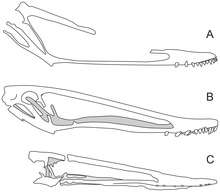Istiodactylidae
| Istiodactylidae Temporal range: Early Cretaceous, 125–120 Ma Possible Middle Jurassic record | |
|---|---|
 | |
| Life restoration of Istiodactylus latidens feeding on a stegosaur corpse. | |
| Scientific classification | |
| Kingdom: | Animalia |
| Phylum: | Chordata |
| Class: | Reptilia |
| Order: | †Pterosauria |
| Suborder: | †Pterodactyloidea |
| Clade: | †Lanceodontia |
| Family: | †Istiodactylidae Howse, Milner & Martill, 2001 |
| Type species | |
| Ornithodesmus latidens Hooley, 1913 | |
| Genera | |
Istiodactylidae is a small family of pterosaurs. This family was named in 2001 after the type genus Istiodactylus was discovered not to be a member of the genus Ornithodesmus.

Remains of taxa that can be confidently assigned to Istiodactylidae have been found in the UK and China, in rocks dating from the Early Cretaceous period (Barremian to Aptian stage).[1] Arbour and Currie (2011) described Canadian Gwawinapterus beardi as a member of Istiodactylidae living in the late Cretaceous (upper Campanian stage);[2] however, Witton (2012) suggested the tooth replacement pattern in this animal does not match that of pterosaurs, suggesting that the species might be non-pterosaurian.[1] Additional research suggested that the species was in fact a fish.[3] The earliest known species might be Archaeoistiodactylus linglongtaensis, from the Middle Jurassic of China;[4] however, it also has been suggested that the holotype specimen of this species might actually be a poorly preserved specimen of Darwinopterus.[5] Hongshanopterus, a supposed istiodactylid from China, has been reclassified as a non-istiodactylid member of Ornithocheroidea of uncertain phylogenetic placement by Witton (2012).[1]
Istiodactylids were medium sized pterosaurs with flat, rounded jaws similar to that of a duck. They had small teeth lining their jaws, however.
References
- 1 2 3 Mark P. Witton (2012). "New Insights into the Skull of Istiodactylus latidens (Ornithocheiroidea, Pterodactyloidea)". PLoS ONE. 7 (3): e33170. doi:10.1371/journal.pone.0033170.
- ↑ Arbour, V.M. and Currie, P.J. (2011). "An istiodactylid pterosaur from the Upper Cretaceous Nanaimo Group, Hornby Island, British Columbia, Canada." Canadian Journal of Earth Sciences, 48(1): 63-69. doi:10.1139/E10-083
- ↑ Vullo, R., Buffetaut, E. and Everhart, M.J. (2012). "Reappraisal of Gwawinapterus beardi from the Late Cretaceous of Canada: a saurodontid fish, not a pterosaur." Journal of Vertebrate Paleontology, 32(5): 1198-1201. doi:10.1080/02724634.2012.681078
- ↑ Lü, J. and Fucha, X. (2010). "A new pterosaur (Pterosauria) from Middle Jurassic Tiaojishan Formation of western Liaoning, China." Global Geology, Z1: 113-118.
- ↑ David M. Martill & Steve Etches (2012). "A new monofenestratan pterosaur from the Kimmeridge Clay Formation (Upper Jurassic, Kimmeridgian) of Dorset, England". Acta Palaeontologica Polonica. in press. doi:10.4202/app.2011.0071.
| Wikispecies has information related to: Istiodactylidae |